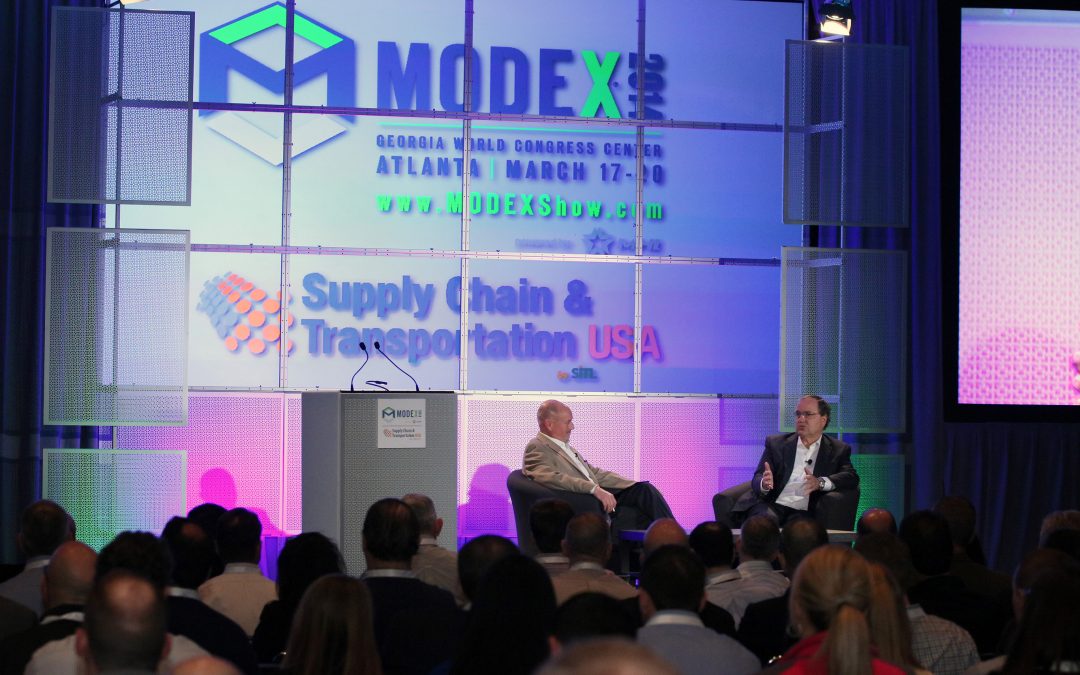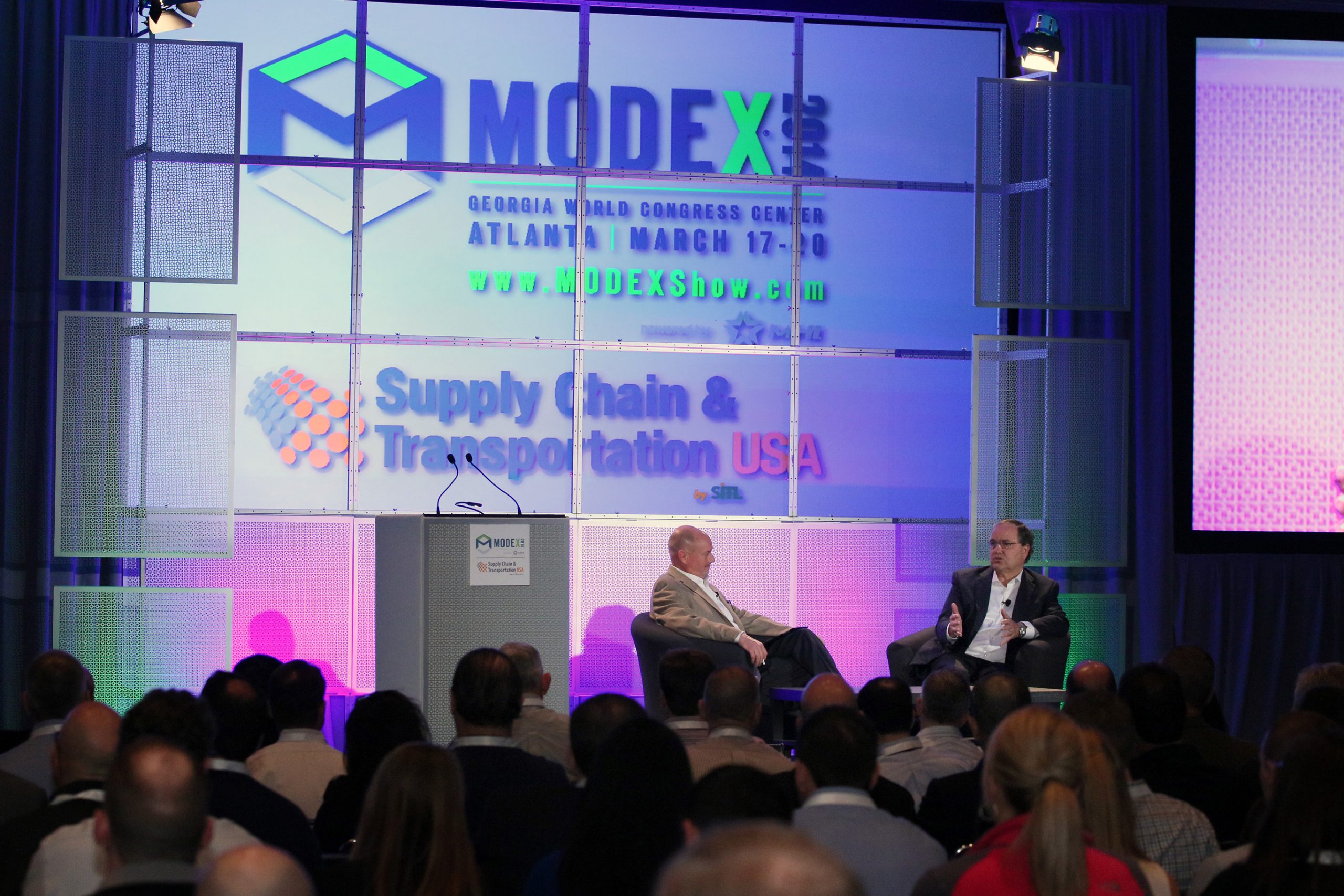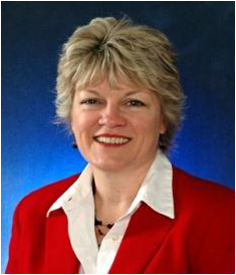
by Fronetics | Mar 31, 2016 | Blog, Content Marketing, Marketing, Social Media, Supply Chain

Employ a content and social marketing strategy to nurture leads you meet during MODEX.
Hundreds of potential customers will be heading to Atlanta next week for MODEX, and you’re gearing up to gain lots of new business. That is, you and over 800 other exhibitors are hoping to gain lots of new business. So how do you plan to stand out among the competition?
Using content and social marketing to nurture leads surrounding the event will help maximize the benefits of attendance. You can bring more attention to your presence, which will help you find more new potential customers, and then you can increase your chances of converting them if you use these tools properly.
Here are some tips for before, during, and after MODEX for using content and social media to gain new business.
Before the show
1) Define your goals.
A trade show represents an opportunity to spread brand awareness, find new leads, and, of course, make sales. Decide what is most important to your business, and strategize around those goals. For example, if one of your goals is to increase your social following, make sure every handout, landing page, and face-to-face interaction includes a request to like you on Facebook (or elsewhere).
2) Promote your attendance.
With the trade show hashtag (#MODEX2016), use Facebook, Twitter, and LinkedIn to let your followers know that you will be attending and when and where they can find you. Engage with other attendees who are using the event hashtag. Offer teasers — such as photos of the freebies you’re bringing — to entice visitors, and provide any longer-form information (e.g., an excerpt from a presentation you’ll be giving) in a blog post, distributing it through your social channels.
3) Set up a landing page/landing pages.
Create an event-specific landing page that includes a call to action (CTA), like reserving a time to speak with you at the conference or downloading a coupon to redeem a free sample. Make sure to ask for some information (such as a name, company, or contact information) in exchange. Monitor traffic and keep a running list of leads who visit and provide their information.
4) Research the attendees.
Perform prospect research using the list of attendees, paying special attention to those who have provided their information on your landing page or connected with you on social media about the event. Check out their social pages to see what they’re saying about the event, and like or follow them. Connect with high-value prospects on LinkedIn and try to arrange a time to meet up during the show.
5) Prepare to nurture.
Draft content that you can distribute during and after the show. Examples include lead-nurturing email templates, slides from presentations you are giving, and other offers you plan to provide visitors. Create another landing page, which includes a special offer or specific information you’ll be providing during the show, to drive attendees to during and after the event.
During the show
6) Keep chatting.
Reach out to the people you meet during the show on their social media handles. A nice-to-meet-you tweet and/or an invitation to connect on LinkedIn shows that you remember and appreciate the potential customer. Send the lead-nurturing emails you prepared in advance.
7) Monitor social media.
Continue using the show’s hashtag to monitor the conversations that are happening online, and see if anyone is talking about your company. Like or reply to anyone who does to show you’re listening.
8) Generate content.
Trade shows are a great place to generate content. Post photos of your booth and attendees from your company, and create videos of product demonstrations, presentations, or customer testimonials. Share your thoughts on the issues being discussed, and keep track of those themes, as well as any recurring questions that attendees ask, for future content.
After the show
9) Plan out your editorial calendar.
Develop posts for your company’s blog over the coming months around the questions and issues that were raised during the show.
10) Keep up the conversations.
Continue to engage the people you met on Facebook, Twitter, and LinkedIn. Follow and like their pages, and invite them to connect.
11) Offer your leads something of value.
Make event presentation or speaking materials part of your lead nurturing activities by sharing them with prospects using Slideshare or email. Remind leads with whom you shared your special-offer landing page to visit. Make sure to segment your contacts based on their interests and send them only relevant offers.
How do you nurture leads around trade shows? Will you be attending MODEX this year?
Related posts:

by Fronetics | Mar 24, 2016 | Blog, Marketing, Social Media, Supply Chain

These four supply chain companies constantly post fresh, quality content to their social media accounts.
When it excels at social media, a company’s opportunity for growth is as vast as the web itself. Today, even small businesses can compete shoulder to shoulder with their biggest competitors if leveraging social media properly.
It is estimated that for every 5 minutes people spend online, 1 minute of that is spent on some kind of social media network. And most of your customers are on social media — statistics indicate that more than 79% of adults in the U.S. use social media each day. As the popularity of sites like Facebook, Twitter, Instagram, and company blogs continues to grow, it is vital to utilize these tools to your own marketing advantage.
When you think of social media masters, you may not think of companies in the supply chain industry. But there are a few excellent examples, and much can be learned from what they do. Here are four supply chain companies that excel at social media and the reasons why they stand out above the crowd:
1) Cerasis
Cerasis, a top freight logistics company and truckload freight broker, excels at social media because their content is fresh, posted daily, and of high quality. Simply put, they create engaging, informative content and are consistently active across all of the major social networks.
2) Kinaxis
Kinaxis, a global company offering advanced supply chain management systems to customers in a variety of discrete manufacturing industries, offers in-depth blog posts and is consistently active in social media channels such as Twitter, Google+, and LinkedIn.
3) Transplace
Transplace, a provider of transportation management services, posts informative articles and incites topics of conversation on Twitter several times per day. The company is active across all social media platforms, including their own YouTube channel.
4) UPS Longitudes
Longitudes is a blog with insights on the trends reshaping the global economy by United Parcel Service, a global leader in shipping. The blog also engages true thought leaders on topics ranging from trade to transportation and ecommerce to emerging markets. Posts are consistently new, innovative, and informative. Longitudes also has its own social media accounts, separate from UPS’s primary accounts, which distribute the blog’s content and engage in related discussions.
Why do these four supply chain companies excel at social media? Here are three commonalities that help these businesses rise above the rest:
Consistent daily posts and content
Having consistent, reliable, fresh social media posts is essential. The more active you are, the greater your outreach to potential new customers.
Think of it this way: search engines pick up on social media activities — like when someone shares content from your website on Twitter or Facebook, for example. Search engines use this to weigh the relevancy and validity of your website and your company. So, fresh daily or weekly content gives people a chance to read and share every time you publish a blog post, ebook, buying guide, case study, testimonial, and other interesting content to your social media accounts. Your marketing efforts reap the benefits of better search engine rankings as a result.
Engaging readers
You want readers to connect and engage with your social media posts. Every time they leave a comment or share or like a post, your social media presence — and your digital footprint — grows.
Quality content
Posting anything just for the sake of posting is not a good social media strategy. Content that is boring and basic will not help your business grow. Content needs to capture the interest of readers and engage them to read, share, and follow your business. Posts should be timely and relevant. This is what builds your following and your brand and generates new customers.
With social media you can find new customers and fans, connect with existing customers who can help spread the word about how great your product or service is, and drive more traffic to your website, which creates new avenues into the digital realm of marketing, company branding, and lead generation. The most successful companies today work daily to improve their social media content and reap the benefits of consistent, quality content marketing.
Related posts:

by Fronetics | Mar 21, 2016 | Blog, Leadership, Strategy, Supply Chain
 When Arrow Electronics came across Kendrea Durr-Smith, senior leader of export control audits, training, and communications at Honeywell Aerospace, on LinkedIn, the company was impressed with what she had accomplished in her nine years there. Now Arrow’s Director of Global Trade Compliance for the last four years, Durr-Smith has led a group that is both unique and diverse, and has helped to shepherd in significant changes.
When Arrow Electronics came across Kendrea Durr-Smith, senior leader of export control audits, training, and communications at Honeywell Aerospace, on LinkedIn, the company was impressed with what she had accomplished in her nine years there. Now Arrow’s Director of Global Trade Compliance for the last four years, Durr-Smith has led a group that is both unique and diverse, and has helped to shepherd in significant changes.
Durr-Smith’s department is unique. “The majority of functional departments at Arrow are regional- or site-specific,” she says; “however, because trade compliance is global by nature, our department is global in scope.” This means that Durr-Smith’s team is diverse, and “not just in terms of gender, but also in terms of background and culture. Learning about these differences and learning how we can best work together has, at times, proven challenging, but is critical to success,” she explains.
Success is something Durr-Smith has achieved. Arrow has made significant changes in the last few years in an effort to better support the needs of customers and suppliers. Durr-Smith and her team have assumed new responsibilities with respect to trade management and compliance in order for these new efforts to be ushered in.
To support these corporate changes and her department’s new responsibilities, Durr-Smith’s department has changed. Three of the most recent hires are women. What is exciting to Durr-Smith is how these women got to where they are today.
“Two of the three women we recently hired are self-educated,” she says. “They were interested in trade compliance, and they educated themselves on the field and took steps to make a career change. This is exciting — exciting that they actively wanted to be involved in this field, and exciting that they were proactive in getting to where they are today.”
Durr-Smith’s enthusiasm for these women’s accomplishments is genuine and speaks to her general ethos. When asked what leadership advice she could provide to others, she offered the following:
“Take on new or different responsibilities whenever possible. Place individuals in different functional areas, and focus on the benefits afforded to both the company and the individuals. Also, focus on helping people grow, and focus on supporting others.”
Thinking about pursuing a career in trade management and compliance? Durr-Smith offers this advice:
“Be flexible. Be patient. Have a good sense of humor. In the field of trade management and compliance, these characteristics are essential.”

by Jennifer Hart Yim | Mar 17, 2016 | Blog, Leadership, Marketing, Social Media, Strategy, Supply Chain

Source: Library of Congress
This is a guest post written by Tania Seary, founder of Procurious. Procurious, the world’s first online social network for supply chain and procurement professionals, has acquired more than 12,000 members in less than two years.
I’m trying to use a baseball analogy here, but appreciate that my headline does have other connotations!
Another analogy might be to say that we’re “getting the flywheel spinning” here at Procurious – the world’s first online network for supply chain and procurement professionals.
Now, for those of you who aren’t familiar with the flywheel analogy, it is a metaphor created by author Jim Collins in his famous business manifesto, “From Good to Great,” to explain one of the key drivers for creating long-term success in business.
A flywheel is a heavy disk on an axle used to smooth a machine’s operation to generate momentum and maintain a constant rotational speed.
It takes much effort and persistence to get the metaphorical flywheel to move, but consistent energy in one direction over time helps build momentum and ultimately leads to a breakthrough. In the case of Procurious, as with Collins’ companies, there has been no specific event, decision, action, or lucky moment that single-handedly helped us to successfully break through the “beta” stage, to where we are today.
Over the last two years, we have remained committed to building something truly special for the procurement profession. Step by step we have stayed focused on our goal of building a very credible and content-rich community for our members.
Now with more than 12,000 members in 135 countries, Procurious has cemented its position as the secret weapon for professionals wanting to be part of the movement toward creating the new face of procurement.
Getting back to our headline analogy with baseball, I wanted to share some of the key decisions we have made along our journey to date to build Procurious.
Agreeing on the MVP
Just to confirm, we are talking about Minimum Viable Product here, not the Most Valuable Player. In the early days of designing this business, everything was up for grabs. Among a long list, we considered building a procurement news aggregator, a pure-play training repository called Procurious TV, and a procurement lifestyle magazine.
What we ended up with was a community platform that included a community feed, member profiles, discussions, eLearning, a worldwide calendar of procurement events, twice-daily blog, and private groups.
The end result was a powerful combination of career advancement, skill development, and professional networking opportunities to help propel today’s procurement professionals forward.
To have open or closed membership?
Once we had agreed on the core features and functionality of Procurious, we had a lot of heated debates over whether we should have an open or closed network. That is, should it be closed exclusively to highly pre-qualified procurement professionals, or open for the whole world to join?
Luckily my team convinced me to keep our network open… and it’s been an important part of our success story to date.
Of course, the major advantage to our members is that on Procurious, they gain access to a wide range of thought leaders and industry experts which then exposes them to diverse opinions on the hot topics in procurement.
Finding our fans
Every club, or community, needs a strong support base. We have been very fortunate to have a number of “early adopters” from around the globe support the building of the Procurious community. And, of course, we now have our “poster child” — Siddarth Sharma — who was surprised to learn he was our 10,000th member. Siddarth is representative of so many of the exciting procurement professionals around the globe — an MBA working for KPMG managing a small team of indirects buyers in India.
Securing our sponsors
Like a baseball club, we needed some big-brand sponsors to keep our operations humming. We have been fortunate to create partnerships with the profession’s leading institutes, associations, analysts, and technology companies. The Hackett Group has supported Procurious from the start, and The Institute for Supply Management (ISM) has joined the team this year. These relationships enrich Procurious in many ways and, most importantly, provide our members with access to world-leading research and resources.
Fielding a winning team
Lisa Malone, Euan Granger, and Jack Slade have been a powerhouse behind building this community, covering all the bases, and getting runs on the board.
Handling the curveballs
The biggest threat to our success is the introduction of a fierce competitor. But we are fortunate that we now have a loyal community that has been built on a substantial foundation of trust and commitment. This will be difficult to shake.
Our next biggest hurdle to success is to overcome the procurement profession’s hesitancy to create social media networks.
Despite the well-publicized benefits, we still meet procurement professionals that tell us “they don’t believe in networking” and don’t accept LinkedIn invitations from people they don’t know. We need to convince the profession of the multiple benefits of using social media, and then provide them with the skills to leverage the opportunity.
One base at a time
Our plan is to continue building Procurious based on our members’ needs, one base at a time.
We will be hosting our Big Ideas conference in London on Thursday, 21 April, for which you can register as a digital delegate on www.bigideassummit.com.
We are also currently beta-testing our new app, which can be downloaded from the Apple App store.
We are asking as many procurement professionals as possible to sign up to the network at www.procurious.com to join this new era and — as we like to say — get involved and get ahead!
Tania is the Founding Chairman of three companies specializing in the development of the procurement profession – The Faculty, The Source and Procurious.
The Faculty is recognized as one of Australia’s leading advisors on procurement development. Established twelve years ago, The Faculty works with leading organizations to transform and elevate the role of procurement, build high performance procurement teams and create professional knowledge networks.
Under Tania’s leadership, The Faculty has instigated a number of “firsts” for the procurement profession in Australia, including the development of a Procurement Executive Program through Melbourne Business School, the establishment of a Procurement Roundtable which includes many of Australia’s leading organizations, creation of an annual Chief Procurement Officer (CPO) Forum and attracting leading global procurement thought leaders to teach in Australia. She also initiated the Corporate Board for Social Procurement, which has created a foundation for leading corporations to dedicate appropriate areas of spend toward social enterprises.
Four years ago, Tania founded The Source, a specialist recruitment firm for the procurement profession. In 2013 she moved to London and founded Procurious, the world’s first online community for procurement professionals to connect, share and learn.
Tania’s fascination and commitment to procurement development started around fifteen years ago in the United States. After finishing her MBA at Pennsylvania State University, Tania became one of Alcoa’s first global commodity managers.
Prior to moving to the USA, Tania’s career was focused on marketing roles within Alcoa and Rowland in Australia, and the Walt Disney Company in the UK. Tania has an MBA and a Bachelor of Business.

by Fronetics | Mar 16, 2016 | Blog, Leadership, Strategy, Supply Chain

Men hold 85% of all executive officer positions within Fortune 500 companies, despite research that consistently shows when women are in positions of leadership, companies perform better. In the supply chain industry, 20% to 30% of positions are held by women, but the dearth of women in the C-suite is astounding; just 5% of top-level supply chain positions within Fortune 500 companies are held by women.
As I have written about previously, the lack of gender diversity in the supply chain is not because women do not have the skillset and ability to succeed within the industry:
“Women are as capable as men when it comes to working within the supply chain industry. Indeed, it has been put forth that women are better suited for roles in supply chain management than men. Research conducted by SCM World found that the majority of men (63%) and women (75%) believe that the natural skillsets of women differ from those of men and that these differences are advantageous for supply chain management.”
Last year I was fortunate enough to interview Cathy Morris, senior vice president and chief strategy officer at Arrow Electronics, and Mickey North Rizza, vice president of strategic services at BravoSolution, about women in the supply chain. Morris was twice named one of the “Top 50 Most Powerful Women in Technology,” and North Rizza was named a “Top Female Supply Chain Executive.” Both Morris and North Rizza shared how they got started in the industry, and the steps they took to get to where they are today. They also shared their desire to increase diversity in the supply chain.
As a woman working within the supply chain industry, I believe that it is important to discuss the lack of gender diversity and point to research highlighting why the industry needs to increase the number of women in all positions, including the C-suite. Additionally, it is just as important to highlight the incredible women who already are working within the industry.
This year I’m turning my focus to showcase the work that these trailblazing women are doing. I spoke with Kendrea Durr-Smith, director of global trade compliance at Arrow Electronics, Kelli Saunders, President of Morai Logistics, Hailey McKeefry, editor and chief at EBN, and Barbara Jorgensen, co-founder and managing editor, EPS News. I also invited Tania Seary, founder of Procurious, to share what is happening at her company, and Jennifer Cortez, director of marketing and communications at Transplace, to discuss the role of quality content within the industry. These interviews and stories will be shared over the next couple weeks.
As I share the work of even more women in the future, I look forward to continuing a dialogue that will hopefully facilitate welcoming more women to the industry.

by Elizabeth Hines | Mar 14, 2016 | Blog, Strategy, Supply Chain
There is no easy answer to the burning question why the onshoring movement refuses to truly take off.
The issue of onshoring is frequently painted in black and white. While the media often likens the return of companies to the United States from overseas to a stampede, skeptics may be too quick to downplay the positive impact of the recent movement in manufacturing.
Nevertheless, those who were looking for a true Renaissance of American manufacturing have reason, at least so far, to be disappointed. Even among some high-profile companies — most notably Apple and GE — that announced their return with great fanfare, reality has set in. GE has battled high turnover rates at its re-opened Kentucky plants, as workers reportedly refused to perform certain tasks, while Apple has been stumped by the shortage of engineers.
Although the number of companies bringing production back home has risen significantly in recent years — from 64 in 2011 to 300 in 2014 — they are still outnumbered by those going in the opposite direction.
However, the issue is more complex than net gains or losses. According to new research by Morris Cohen, a Wharton School professor of operations and information management, and Hau L. Lee at Stanford University, “There is an unprecedented amount of restructuring going on.” In some cases, departments within the same company are onshoring and outsourcing at the same time, each weighing the perceived pros and cons differently.
In a Knowledge@Wharton interview, Cohen elaborated on the trend: “I’m going to go to China. I’m coming back from China. The same company simultaneously is making what seemed to be opposing decisions. And when you asked them why, they would give the same reasons. It’s because of labor costs. It’s because of market access. It’s because of this and that.”
In fact, they found there appears to be no dominant reason why companies make one decision or another in favor of onshoring or staying put.
And barriers seem to remain the same as when the onshoring movement began to gain momentum: The lack of skilled workers, coupled with an aging workforce, still rank high on the list of negatives. The rapid pace of offshoring in 1990s and early 2000s made younger generations lose faith in the viability of a manufacturing career.
Patrick Van den Bossche, the Americas lead partner at A.T. Kearney’s Strategic Operations Practice — which released its inaugural Reshoring Index last year — explained the problem on Manufacturing.net: “Think about it — if you have a kid in school, with everything that happened in the last few years, with manufacturing moving overseas as fast as it did, would you feel comfortable to tell your kid to develop a career in manufacturing? I don’t think so.”
At the same time, countries like China, Brazil, and Eastern Europe, previously known for their low-skilled labor, are quickly improving and investing in high-tech industries. With a greater pool of skilled workers abroad, a move back to the United States will seem less urgent. And with the arrival of robotics, the issue of labor costs will likely take on even less significance.
So the big question is, how should the United States stand up to the competition? What do you think?
A version of this article previously appeared on EBN Online.










